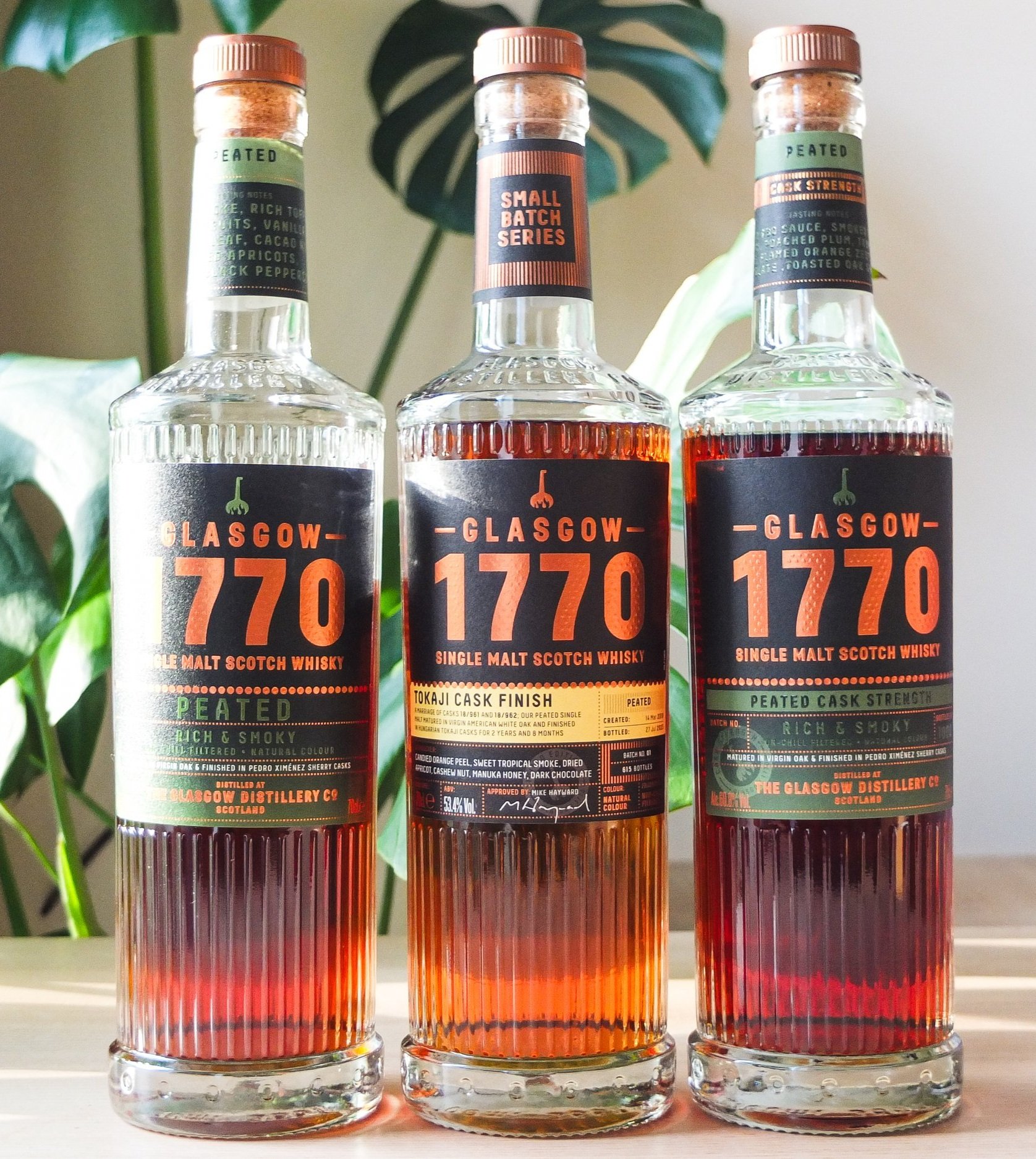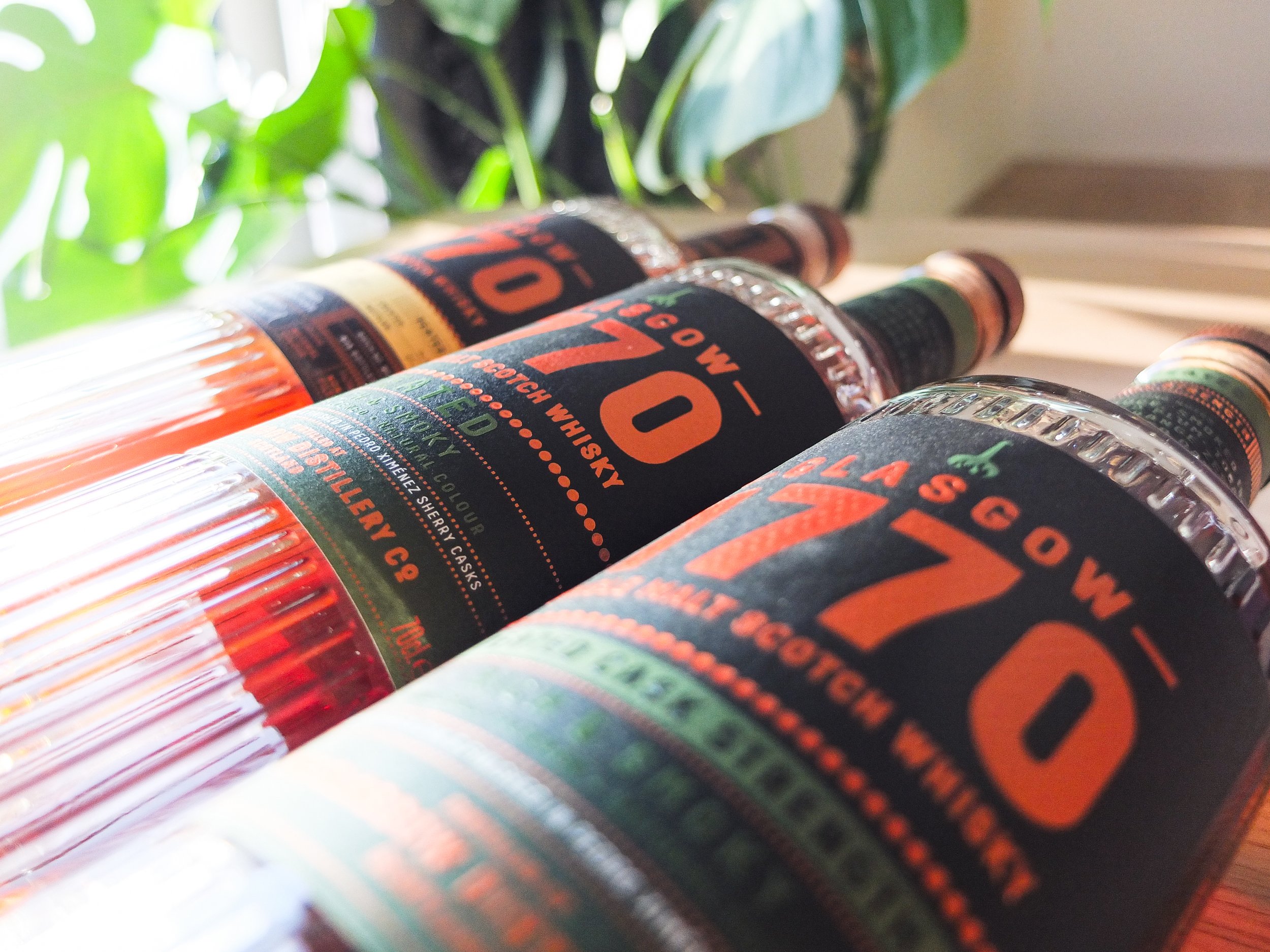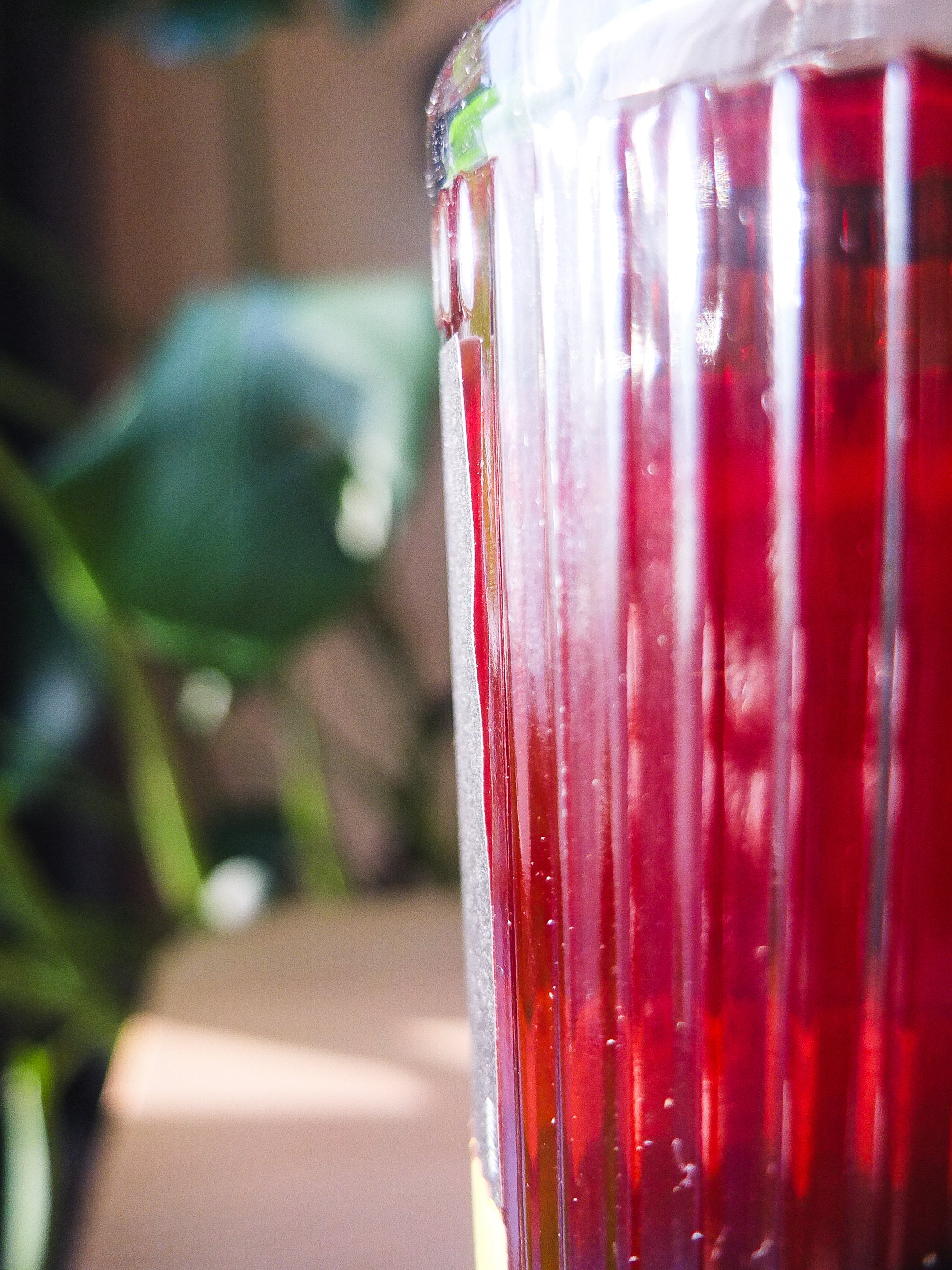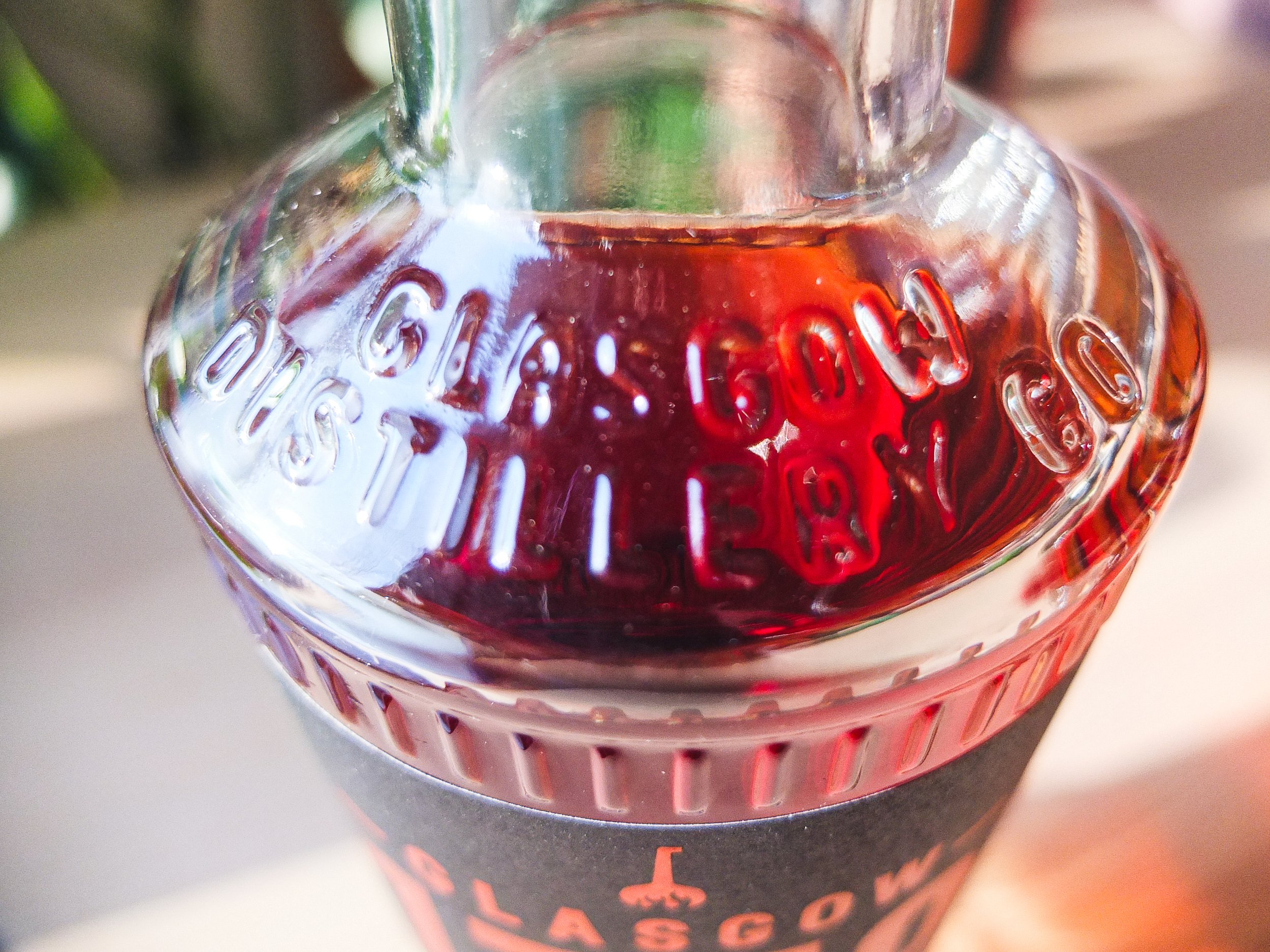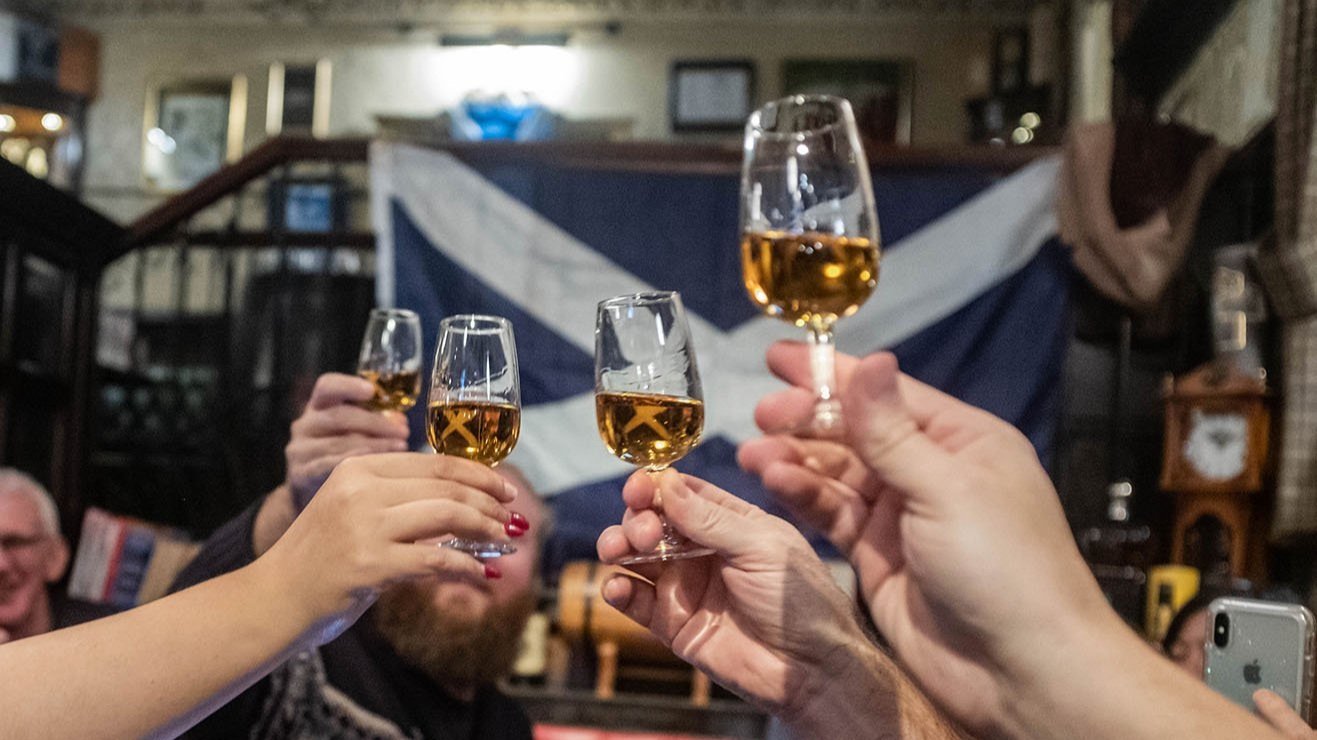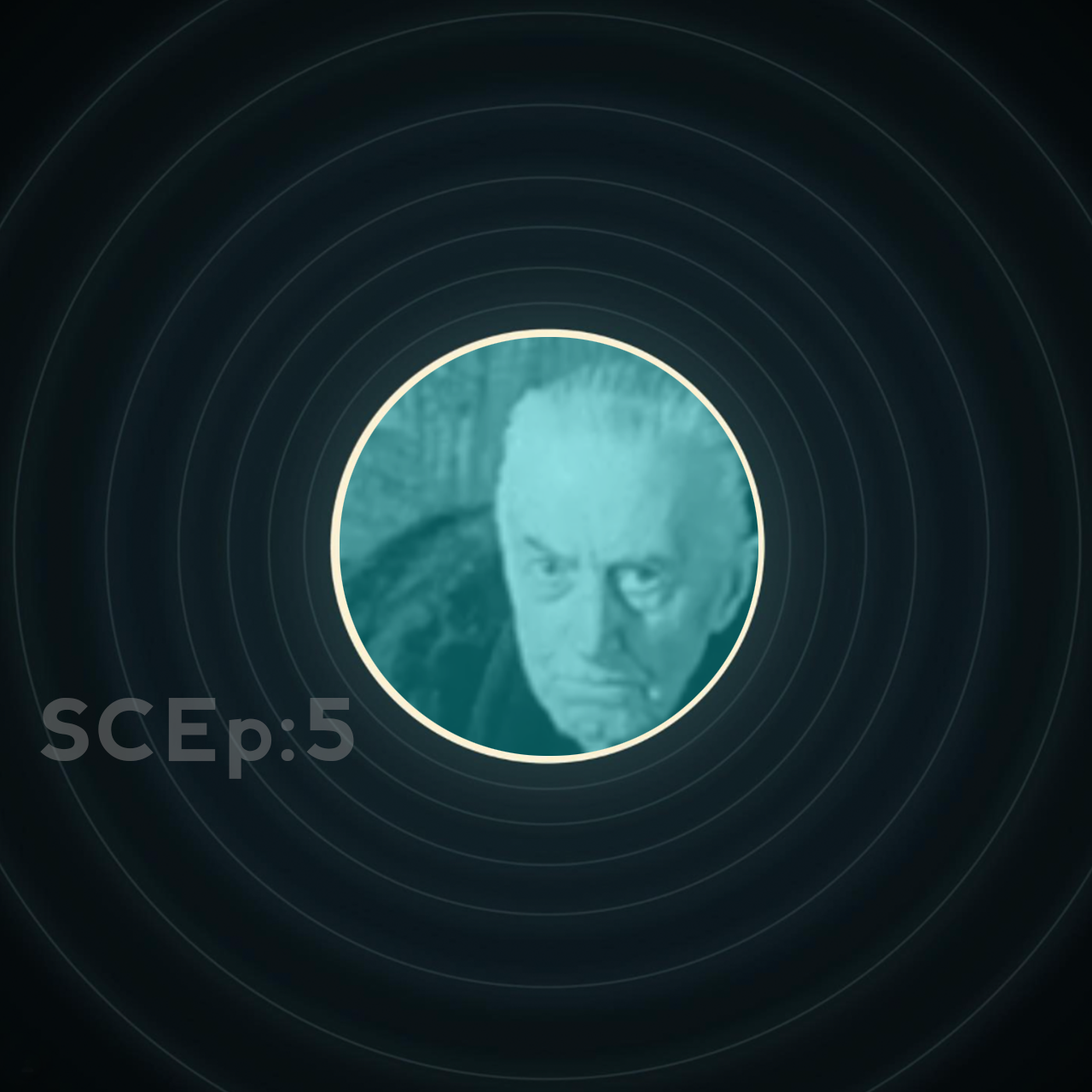Glasgow Distillery Peated Trio
Peated PX, Cask Strength & Tokaji Ltd Ed. | Various ABV
Score: 7/10
Very Good Indeed.
TL;DR
Already very good, with promise of greatness
Bearing witness to a grand experiment
It seems that today we are lucky witnesses to a grand “natural experiment” currently in the works.
I don’t mean laboratory beakers filled with bubbling liquids carefully handled by scientists in white robes and goggles. I don’t even really mean master blenders in their blending labs with reams of samples in front of them carefully figuring out the cask composition of their next release. No, I’m referring to the fact that there is something of a “natural” experiment currently at work in how new(ish) distilleries are approaching the first releases and their crucial first few years of existence with their tentative first steps into a crowded, shoulder-to-shoulder whisky market.
Let me back up. You, fellow Dramfacers, know me as Drummond, your occasional and humble whisky correspondent, one of many fine folk here at Dramface HQ. By day, however, I am a worker bee social scientist, teaching students, grading piles of papers, doing soul-destroyingly dumb bureaucratic paperwork and, when I can, conducting research in my field.
Social scientists generally don’t do experiments anymore. Our colleagues over in the natural sciences of course do experiments all the time. They manipulate and control variables to isolate cause-and-effect relationships to find out how things work between atoms, molecules, trees, blood cells, growing tomatoes, gases, steel cables, and lots of other things. I have a physicist friend who works with lasers, and although I never understand a word of what he’s talking about, it’s always super cool and interesting, nonetheless.
Social scientists study people and societies, and it’s much less ethically practical or advisable to manipulate people in the same way. Take the (in)famous and highly ethically dubious psychological study conducted by Stanley Milgram in the 1960s which tested peoples’ deference to authority by goading them to electrically shock people (it was all staged, unbeknownst to the subjects, mind you) unseen but very much heard screaming behind a curtain right next to them. Ah, the good ol’ days!
It’s probably a good thing that we now have institutionalised ethics processes that have long since put the kibosh on such things.
So what is a “natural” experiment as opposed to a normal experiment? In a conventional controlled experiment, the researcher assigns subjects to different groups, which are as close as possible except for the treatment. This way, the causal effects of the treatment (whether it’s effects of a pill, blasting varieties of building materials with heat and stress, or subjecting rats to diseases) can be isolated and determined.
In a natural experiment, the researcher has no real control over these things. Rather, these are when naturally occurring conditions give us situations where differences in “treatments” across similar subjects can help us identify causal effects (even if it’s ultimately impossible without full control over the relevant variables and groups). Interested in how citizens and voters will react to different kinds of tax laws? Who isn’t! Find a few similar countries with similar types of populations, governments, and economies and see how their different tax laws have affected their politics. Fascinating, right? Right??
It's not a perfect metaphor, but we have a similar situation in whisky right now. With lots of new distilleries coming online with their first releases over the past few years, it’s easy to see how the relevant population (ie, us) react to these different, ahem, “treatments.” Annandale, if you consider them new, charging over £100 for their first release of young whisky? The result was almost instant and continuing disengagement from our community of enthusiasts. The treatment was too much and they simply killed off their (potential) subjects. Falkirk selling their initial bottles to the highest bidder with deepest pockets at auction before then turning to the community to claim with a straight face that they “can now begin to tell their story”? Disappointment, disbelief, and scepticism has been the result.
Other distilleries have chosen different “treatments” and have fared better. Lindores and Lochlea, for instance, have priced more fairly, which has created more interest and a bigger fan base for both of them. A variety of core releases but also with flurries of finishes, single casks, and special editions also seem to have created a sense of something approaching saturation.
Other newbies seem to be striking a more even balance between the treatments of product, price, and value and then carefully observing and monitoring the effects. Ardnamurchan, of course, seems to be doing most if not everything right. Kingsbarns continues to offer decent value for their core range bottles, and a recent sip of the Doocot I was able to try clearly shows an advance over the Dream to Dram and well demonstrates that the spirit is maturing in positive directions.
Raasay’s core range bottles tend to be similarly good quality for reasonable prices. Torabhaig, I’ll suggest, is doing things well – a single core range release bottle of great quality – with the next one evidently coming soon – without that deluge of overpriced “limited editions.” That patient focus on making the best singular house style that they can illustrates a confidence that says something very different – and in many ways, more appealing – than the saturation approach.
I’ll further suggest that although it hasn’t been quite as visible on our collective whisky radar as some of these others, Glasgow Distillery should be more firmly on your radar. Yet, they haven’t always been high on my own personal radar because of a “treatment” early on that didn’t sit well with me; a choice to release 50cl bottles. There’s no objective reason for a 50cl to put me off, but it did. Maybe it did you too. There’s something about a 50cl bottle that makes me feel I’m not quite getting my money’s worth – even if objectively I’m wrong. But, they fairly quickly switched to the more conventional 70cl bottles – without raising their prices – and they seem to have gotten more attention after this. Kudos to them for shifting gears.
As Ramsay recently discussed, Glasgow Distillery is a newbie but has in fact been producing spirit for nearly a decade now. They make their location in the city of Glasgow a key part of their story with the “1770” label, referring to the founding date of the original Glasgow Distillery, even though there’s no real link between that and today’s Glasgow Distillery (the original distillery site at Dundashill is far from the current site in Hillington, for example).
It’s on the smaller side as Scottish distilleries go. The Malt Whisky Yearbook tells us that they produce 500,000 litres per year, which puts them in the same league as Benromach, Torabhaig, Ardnamurchan, and Glenturret. They have a well-defined and fairly priced core range consisting of The Original, Peated, and Triple Distilled – ticking all the geek enthusiast boxes of 46%, nonchillfiltered, and no added colour. This is fairly standard but certainly makes sense in terms of giving customers a few different permutations of the spirit. They also produce a variety of other spirits and blends to keep things running. Two of today’s bottles – the Peated Cask Strength and the Tokaji Cask Finish – appear to be the first batch of cask strength releases with some different finishes.
Why did I take the plunge and purchase my first bottle? I’d tried the standard Peated 46% in a pub and found it interesting and enjoyable, and so when the Distillery itself promoted an offer toward the end of last year bringing the bottle down to £44, I took a punt. After enjoying it for a couple of months, I saw that they’d released a cask strength 60.8% expression with the same cask make-up, I was eager and interested to try a significantly amped-up version. It was £64, seemingly a lot of money for what was inevitably going to be a young whisky, but as Ramsay points out when compared to other releases from similarly-aged new distilleries, these are actually reasonably priced in today’s market.
On we go with a Glasgow Distillery peated trio….
Review 1/3
Glasgow Distillery Peated, PX Finish, Core range bottling, 46% ABV
£49 RRP, £44 paid and widely available
Glasgow’s core range Peated expression helpfully tells us on the label it was matured in virgin oak and then finished in PX casks for an undisclosed period.
I do like the bottle design; slightly oval-shaped when looked at from above and below, and with the art-deco-style fluting it makes for a nice grippy feel in the hand while pouring. One gripe though; each of today’s bottles has a QR code on the back, which I was eager to scan since I thought it might lead to some additional information about casks, maturation, or whatnot. Unfortunately, this isn’t the case, as the codes simply take you to the distillery’s website.
It would be great – and would help Glasgow to stand out even more in a crowded pack – if some useful information about the bottle was included here. I realise that blockchain technology and all costs money, but still an expression summary could be more useful. Perhaps in the future?
A quick peek at the website informs us of the concerto barley smoked to a 50ppm level using Highland peat.
Score: 6/10
Good Stuff.
TL;DR
Already very good, with promise of greatness
Nose
Rich spicy smoke. The sweetness and smoke both take centre stage hand-in-hand on the nose. The smoke is reminiscent of smouldering campfire embers rather than, say, vegetal or ash tray. Oak/wood spice alongside PX sherry spices. They’re a bit overpowered on the nose but in the background are some light fruits – green apples and pears.
Palate
Rich spicy smoke again, but now right alongside oakiness. The virgin oak maturation becomes much more apparent on the palate – in a good way. The PX is strong but not domineering and helps to round off the oak from becoming too prominent. The spice notes are coming from both the PX and the virgin oak, and they blend in a way that brings a distinctiveness to this peat n’ sherry dram that sets it apart from other peat n’ sherry malts that I enjoy (and which aren’t matured in virgin oak, such as Benromach’s Peat Smoke Sherry Cask, and Ardbeg’s Uigeadail). It’s not super complex, and sometimes over the past few weeks it’s felt slightly thin on the palate. Yet, to check the mouthfeel I try this alongside a dram Ardbeg 10, and the mouthfeel holds its own. Nice finish, if not super-long, but somehow moderately sticky and mouth-coating despite what I just said about mouthfeel.
The Dregs
This is good stuff. It’s young, true, and as such doesn’t have the development or depths that older malts will have. But it’s full of flavour, and it surprisingly has some integration that speaks a bit beyond its age. It tastes integrated and married like an older malt even if those layers haven’t yet developed, which itself speaks to the skill with which this expression was put together.
Trying it alongside the stalwart Ardbeg 10 and finding that while not quite on the same level (the Ardbeg is likely nearly double the age of this, and bourbon maturation of course), as a young malt, this surprisingly holds its own. Peat, sherry, and virgin oak – I now see why this style was chosen for this spirit: it’s a full-flavoured dram which pulls together these three powerful influences together in a way that makes for a unique experience in the peat-plus-sherry category. As a confessed peat n’ sherry freak, I can’t help but like this, and for me it’s better than our average of 5/10. 6/10 – so sue me.
Score: 6/10
Review 2/3
Glasgow Distillery Peated, PX Finish, Cask Strength release, 1,000 bottles only,60.8% ABV
£65 RRP, wide availability at time of writing
Like its 46% little brother, the Peated Cask Strength was also matured in virgin oak before being finished in PX casks. A small batch of 1000 bottles as indicated on the label.
Score: 7/10
Very good indeed.
TL;DR
A big whack of flavour. Powerfully enjoyable
Nose
Trying this right after the 46%, the difference in ABV hits you right in the face.
A bit spirity on the initial plunge of your nose into the glass, but once your system adjusts to that 60.8%, you get the same nose as the little brother but amplified: campfire ember ambient-feeling smoke and bold thick PX. But, how this differs from the little brother are the fruits coming through, more so on the nose; a combination of stewed fruits and berries: lemons, apples, and blueberries.
Much less oak on the nose than the 46%.
Palate
Big, bold, and inviting.
PX-smothered ember smoke; sitting around a campfire in my comfy camping chair covered with a blanket when the wind blows smokes in my face while sipping sticky PX.
The virgin oak influence is making more of an appearance now than it did on the nose – but pleasantly so. That same combination of peat, sherry, and cask oak is a fine blend of flavours that offers this a distinctiveness. Sweetness not just from the PX but from the distillate as well: hints of citrus lemons, berries, and other fruits. Thick and mouth-coating (watch the legs slowly ooze down the side of your glass) – minutes after gulping I’m still tasting it.
Again, like the 46%, it doesn’t have depths or layers that an older malt would have. Going back to the Ardbeg 10 that I’m sipping here alongside my Glasgow 1770 flight, it’s clear that it has developed depths that this doesn’t have. But, the full-flavoured punch of this not only makes for a different but also a powerful and satisfying experience compared to the Ardbeg.
The Dregs
This is very good indeed. Again, as a young malt it’s lacking the depth that, say, this Ardbeg has at 10 years, but it more than makes up for this with a big whack of flavours that command attention and don’t let go.
As the bigger, brasher brother of the 46%, this is everything that dram is but dialled up to 11 (insert This is Spinal Tap joke here). Yet at the same time, there are distinctive notes: some more berries amidst the embers and PX sweetness, and a more complementary virgin oak influence. This is great stuff, but like I said earlier – and cards on the table – peat and sherry is one of my favourite lanes to travel in. But I’m looking at our scoring system and I’m landing close enough to 7 that I’m going for it. 7/10 it is for this Glasgow Distillery Peated Cask Strength. You might think that’s overly generous. But, we’re not averse to giving good scores to young malts from new distilleries if they warrant it.
If you’re looking for something reasonably priced that’s big, powerful, and which packs a rounded full-flavour punch, try this. If this is your lane, too, I don’t think you’ll be disappointed.
Score: 7/10
Review 3/3
Glasgow Distillery Peated, Tokaji Finish, Cask Strength limited edition release, batch 1, 615 bottles only, 53.4% ABV
£65 RRP, available at time of writing
Tokaji casks are rare in Scotch whisky. The only other whisky that I know of that used Tokaji casks was Glenmorangie’s Tale of Cake from a few years ago. I didn’t get to try that one, but most of the reviews spoke of a distinctly sweet character. Some quick Googling tells us that this is a sweet white wine from the Tokaj region of Hungary or the adjoining Tokaj region of Slovenia.
Unlike the 46% and Cask Strength Peated, the label here actually gives us a “created” date of 14 March 2018 and a “bottled” date of 27 July 2023, making this five-and-a-bit years old. We’re also told it’s part of their “Small Batch Series” with 615 bottles and Batch 1, and a quick peek at the website tells us that this is a vatting of two casks, so, the smallest batch possible outside of a single cask.
We also get more information on the website about maturation; 2 years and 8 months in virgin oak, and 2 years and 8 months “secondary maturation” – which seems indeed more accurate than the “finish” indicated on the bottle label, even while the bottle does indicate the “finish” of 2 years 8 months. They also tell us there that they’ve previously used Tokaji casks with their Triple Distilled and some unpeated new make. Between the label and the website, we’re thankfully able to pull together quite a bit of information about this bottle. More kudos for more transparency.
Speaking of which, the previous two bottles I bought myself, and I was already teeing up this comparison review when a message popped into our Dramface writer’s group offering anyone a bottle for consideration. Wally doesn’t make any promises and if we decide the review is worthy we put time into it, without any obligation. The timing, for me, was uncanny. Why not make it a triple peated review? This bottle arrived, free of charge and courtesy of the distillery team, a little later.
No one has made any requests of me. These are my own thoughts.
Score: 7/10
Very good indeed.
TL;DR
Mouth-coating, tropical and unique.
Nose
Honey, sweet bright fruits, and honeyed vanilla. An orange peel quality married with a warm vanilla pod shake that’s maybe had gentle smoke blown over it. The website indicates that this began its life as peated new make, so we can assume that it’s 50ppm level, but the nose here would not indicate that – the peat is subdued here compared to the Peated Cask Strength (albeit the ABV is lower here). The official bottling notes here are spot-on; manuka honey, candied orange peel, and sweet tropical smoke.
Palate
Thick, sweet, and full. Hints of bitter dark chocolate alongside a continuation of the nose: honey, bright fruits/oranges, and vanilla pods.
The peat comes through alongside the manuka honey-vanilla pod-tropical quality without either dominating it or itself being dominated. In fact, despite being peated spirit presumably to the same ppm as the above Cask Strength, this doesn’t come across nearly as peated as that dram. The peat is still of a campfire ember-quality, but it’s much more muted here. Not to its detriment, just different. Rich, thick, and creamy. Very nice mouthfeel and texture: sticky and lingering.
The Dregs
This Tokaji cask strength is thoroughly enjoyable and dangerously quaffable at 53.4%.
It doesn’t hit with the same force as the Peated Cask Strength, but instead oozes onto and coats your palate with a sweet, tropical gently smoky thickness that offers a distinct experience from the other two expressions. I can’t recall trying another peated dram quite like this; it’s a unique experience. And a damn good one at that.
Well, it’s safe to say that Glasgow Distillery is now firmly on my radar. For me, these take their place among my personal favourites among the newer distilleries, and the two cask strength releases particularly are just simply very good. While they are young, they are surprisingly and pleasantly rounded for their age. Part of this is of course due to some heavy but skilful cask influence, but it’s evident that the spirit itself has been made with care and consideration. It’s not rough, jagged, or spirity in the ways that you might expect young, even well-intentioned spirit, to be.
It’s also true that young peated whisky can often be more engaging than non-peated young whisky, and as all of these are peated, I wonder how much of a difference this is making between my experience with these and Ramsay’s take on an unpeated expression. It’s not spirity in the way that Lochlea is to me. It’s not slightly thin in the way that Lindores is to me. It’s definitely young, as Ramsay rightly points out, and it hasn’t yet developed the layers and depths that a whisky with some age has.
Yet it does taste a little older than other new-ish distilleries – perhaps some of their older stock has been included here. But, these are full-flavoured, and the flavours themselves – their combinations, delivery, and development – are wonderfully promising. Among the raft of new distilleries I’ve tried, I’d put Glasgow Distillery in that upper-tier alongside Torabhaig, Kingsbarns, and Raasay – even if not quite in that tippy-top tier with Ardnamurchan – in terms of not only where it is now but also the promise it’s clearly demonstrating with these three expressions.
With much of the discussion in whisky right now around value – when we’re getting reamed by so many cynical moves by some of our favourite distilleries and their owners - as well as many indies – it’s the promise shown by these new distilleries that should give us hope. They give me hope.
Yes, it’s a time of price gouging and widespread cynicism, but it’s also a time of innovation, new players focused on flavour, enthusiasm, and relationship-building, and exploration by those not tied solely to short-term thinking. Try Glasgow Distillery if you have a chance, alongside some of the other better young distilleries. Take part in this ‘grand experiment’. They might give you hope, too.
Score: 7/10
Tried these? Share your thoughts in the comments below. DD
-
Dramface is free.
Its fierce independence and community-focused content is funded by that same community. We don’t do ads, sponsorships or paid-for content. If you like what we do you can support us by becoming a Dramface member for the price of a magazine.
However, if you’ve found a particular article valuable, you also have the option to make a direct donation to the writer, here: buy me a dram - you’d make their day. Thank you.
For more on Dramface and our funding read our about page here.
Other opinions on these:
Whiskybase (PX Peated Cask Strength)
Tokaji Cask - Nothing yet 🤷♂️
Got a link to a reliable review? Tell us.

